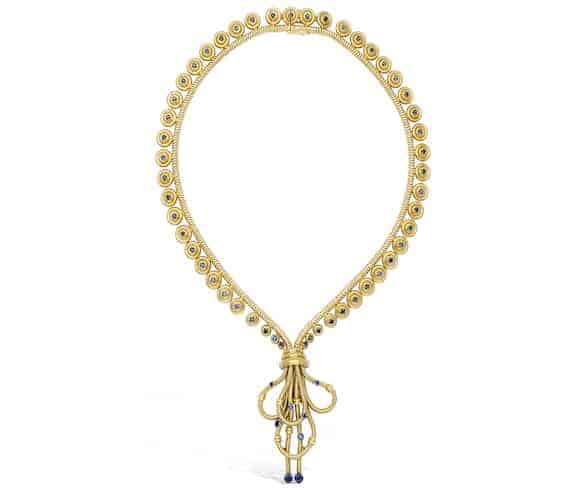
When it comes to appreciating antique jewels, uniqueness is key
by Duncan Parker
In the conception of any piece of jewellery, the ultimate goal is to create beauty that lasts. However, enduring beauty is about more than just quality: for a jewel to maintain its magnificent aura, it must capture the heart of its viewer.
At Dupuis Fine Jewellery Auctioneers, we recently held an auction that featured a large collection of jewels from the late 19th and early 20th centuries. These unique jewels sold very well, with high demand and larger-than-expected profits.
So, why did these jewels sell so well? Are there certain elements of design or materials that make these pieces timeless? As it turns out, the answer is much more simple than you’d think: these pieces are truly one-of-a-kind.
One in a Million
Obviously, antique jewels aren’t being made today. While today’s jewels will eventually become vintage and may retain their sensational quality, they simply don’t have the cachet of older, more classic designs.
The aforementioned vintage jewels didn’t sell so fabulously because they are old, but rather because they are pretty, interesting, singular, and, therefore, durable. This great resilience stems from their exceptional nature: they were in high demand for resale due to their rarity.
Now, consumers often feel that they can’t afford custom-made jewels. However, they don’t have to be costly: individually designed pieces can be suited to lower price points, as well. Often, I see potential buyers spending $20,000 on a diamond ring from a catalogue, while they could’ve had a handmade, custom designed tourmaline piece for only $4,000.
Recently, a Victorian brooch was offered up for auction. The small piece featured a nondescript, greyish-yellow tourmaline cat’s eye cabochon in the centre, and was finished with a narrow, black and white enameled bar. It was a simple, but elegant design, the desirability of which lies in the details. While it is a lovely piece of work, its uniqueness comes from the man who designed it: the brooch is signed with the initials “CG,” for Carlo Giulano—one of the most sought-after jewellers of the Nineteenth century.
Although a brand name or signature can add to a piece’s sense of grandeur, it is no guarantee of its true value. When I began my studies in gemmology, I was told that beauty, rarity, and durability are the main facets of a stone’s true value. These ideas, especially rarity, also apply to jewellery: a jewel that is mass-produced is likely to be in lower demand in the future.
It follows that a jewel of which there is just one, or only a few, has likely been custom made. I recently visited the Tiffany store on Fifth Avenue in New York. While its showcases were populated by fabulous jewels, the tourists around me were most attracted to one specific display: Jean Schlumberger’s collection for Tiffany. These pieces are a perfect example of custom design and limited production. While they are not one of a kind, they retain a significant element of resale value due to their rarity and origin.
Design
Of course, design also plays a role in maintaining durability. While there has
always been good design and bad design, stylistic disparities between different eras are also common. In recent times, we have seen strong demand for jewels from around 1800 to 1930. At that time, most precious jewels were one of a kind, and many have been damaged or reinvented, making them even more rare.
That being said, uniqueness doesn’t make something desirable, nor does it mean there is a resale market for it. While grandma’s ring, mum’s pendant, or Aunt Florence’s brooch may hold sentimental value, hand-me-down items may be flawed in design, with mismatched or low-quality stones. When these jewels are presented for possible consignment for auction, the chance of receiving a strong bid is almost non-existent.
Beauty of design really is paramount. Simple elements of geometry or influences from nature are common in the most enduring jewels. The imagination and skill of both the designer and the goldsmith contribute to a jewel that will easily bridge generations, and will gladly be accepted as a gift from grandma. However, this is not a universal rule: styles come and go, and some are gone forever.
Art Deco seemed very durable as a style, with its jewels likely to remain in constant demand. In the past year, we’ve seen Art Deco’s wonderful geometry selling at auction—still strongly, but less aggressively than in the past.
There may not be a single formula for durability of design, demand, and accepted beauty in a jewel, but there are some consistent tendencies. Keep these in mind, and you’re sure to craft a design for the ages. CJ
Duncan Parker, FGA, FCGmA, CAP (CJA), has been an instructor of the gemstone course at Ryerson University, the Gemmology courses of George Brown College and Canadian Gemmological Association as well as instructor of the Master Valuer Program with the Canadian Jewellers Association. A renowned expert, he speaks regularly at international gem and jewellery conferences and symposiums, as well as at less formal events.

















